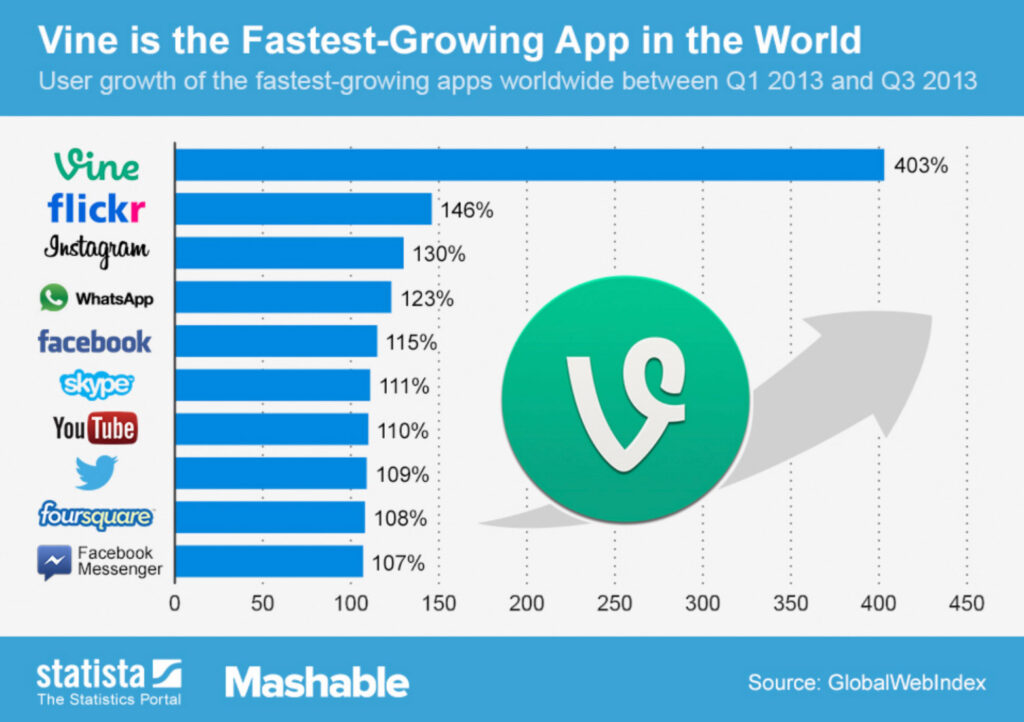April 25, 2024
The Life of Vine
Leslie Barboza

As a 20-something working in social media, I think about Vine too often. How could I not? For an app that had a life span of four years, it set the precedent for what social media is today. It was an industry disruptor—the beginning of short-form video and what we know as the social media standard today. Vine unlocked a level of creativity on social media we hadn’t seen before. In Gen X terms, Vine walked so TikTok could run.
Let’s stroll down memory lane to see where Vine went wrong, how we got to where we are today, and what we can learn from the late Vine app.
Vine launched on January 24th, 2013, and officially shut down on January 17th, 2017.
Initially created by Dom Hofmann, Rus Yusupov, and Colin Kroll, Vine was quickly bought by Twitter (now called X) for $30M so that its users could share short video clips of their daily lives in loop format via Twitter—a video tweet if you will. However, the young folk of 2013 were simply built differently and took the 6-second video cap that Vine offered as a creative challenge.
While initially meant to be a convenient Twitter feature, creators took to the Vine app and began building their fanbases. Vine offered less than a fraction of our luxuries now with TikTok alone. It had a simple record-and-send posting process, which forced creators and brands alike to get innovative with the default looping feature, video cutoffs, and delivering storylines and/or punchlines within 6 seconds! There were no music tracks, video cropping tools, auto-recording, third-party editing, or boosted posts—nothing but pure ingenuity and adaptability.
Because of these strict limitations, entertainment, humor, and pop culture took on a new form. We found creators like King Bach, Brittany Furlan, and Rudy Mancuso. We saw more of Josh Peck. We coined terms like “What are thoooose???” and “Anything for you, Beyonce.” We watched the success of Vine’s Quinta Brunson, who gained popularity for her “Girl who’s never been on a nice date” skit series and won a couple of Emmys for her sitcom, Abbott Elementary (a highly recommended watch).

By the end of 2013, Vine was the fastest-growing app in the market, and meme culture was growing just as fast. If you weren’t witness to the rise of Vine, let me share a few of the most coveted, quoted, and beloved Vines of the 2010s:
- Road work ahead?
- And they were roommates.
- It’s an avocado. Thanks.
- Stop, I could’ve dropped my croissant.
- Look at all those chickens!
- A potato flew around my room…
Now that we have a detailed grasp of the kind of content that lived on the app, we can easily see the difference between Vine and its competitors. However, being the most popular and fastest-growing doesn’t cut it. Have we learned nothing from the tortoise and the hare?
By the end of 2016, Twitter had thrown in the towel on their Vine venture. Simply put, Vine was not equipped to support the success and growth it experienced, and its parent company, Twitter, had more significant priorities. Vine’s top creators weren’t receiving the support they needed to scale their growth. Monetization tools were unavailable, support teams for creators were non-existent, and the app was not letting up on the 6-second video limit.
Issues between creators and the looping app forced top Viners to seek other platforms that facilitated their needs. Instagram had quickly caught onto the trouble happening at 1600 Vine Street. To their benefit, they released their 15-second video feature and had existing celebrity endorsements to push the release, which took many of Vine’s big stars. Competitors like YouTube already provided longer video lengths and monetization, which took even more Viners. Snapchat took in its fair share of users by adding features like Snapchat streaks. With the detrimental lack of creators, users, and advertisers engaging with the app, Vine officially shut down on January 17th, 2017.
During the chaos of Vine’s rapid increase and decline in popularity, Musical.ly remained steadfast since its conception in 2013 until ByteDance bought it in 2017. Then, it merged with ByteDance in 2018 to present TikTok to the world. (Remember the tortoise and the hare?) It is now the most popular, fastest-growing app in the market. It has provided everything Vine fell short of and even threw in an auto-feed feature that uniquely curates feeds for TikTok users.
There are many takeaways from Vine’s rise and fall, but the most important is that adaptability, finesse, and quick action are required when working in/with the social media industry. Social media is a beast of its own kind and changes at the drop of a hat; sometimes, sitting back and learning from your competitors is the best route to take at the time.
Lastly, influencers, content creators, and creative teams must take the lead on social media. They are the connective tissue between people and brands by using various mediums and can very well make or break a social media app. Continuing to ensure creators of any kind are listened to with an open mind and provided support allows brands to create magic in their communities.
Get insights delivered straight to your inbox.